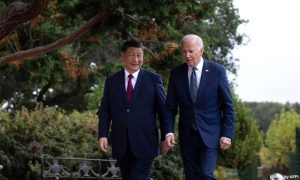ISLAMABAD: The United Nations top agency has called for urgent efforts to overcome the challenges of air pollution and protect children’s health, as more than 11 million children under five years of age are exposed to toxic smog in the worst affected districts in Punjab province of Pakistan.
“As smog continues to persist in Punjab, I am extremely concerned regarding the well-being of young children who are forced to breathe toxic air,” said the UNICEF Representative in Pakistan Abdullah Fadil.
UNICEF representative urged Pakistan to take more aggressive measures to ensure children’s “right to clean air,” advocating for stricter emission laws and a shift toward sustainable energy, UN agency official website said.
Lahore and Multan have recorded extremely high AQI levels, with Sialkot peaking at a shocking 774, according to the Air Quality Index.
With COP29 in progress, the call to action is timely, as global leaders have a unique opportunity to transform climate pledges into real steps toward cleaner air and a healthier environment for Pakistan’s future generations.
The root causes of this smog crisis include cross-border crop burning in India and Pakistan, vehicle emissions, and coal-fired industries.
Temporary green lockdowns have been imposed, like school closures and restricted traffic, but citizens and experts alike see these as short-term solutions.
A sustainable answer might lie in expanding public transportation, enforcing stricter emissions laws, and fostering international cooperation to address this borderless issue more effectively.
NDMA
Amid increasing intensity of toxic smog in the South Asian country, Pakistan’s National Disaster and Management Authority (NDMA) has advised the public to minimize outdoor exposure and use protective measures like masks to combat the rising health risks.
It has recommended staying hydrated, using air purifiers, and adopting eco-friendly transportation methods to mitigate smog’s effects on health.
READ ALSO: Toxic Smog Triggers Heart Attacks, Strokes and Suicides: Health Experts
A debate is underway in Pakistan, how to tackle smog in Pakistan as many countries and cities across the world passed laws and implemented regulations to overcome smog.
How World’s Major Cities Tackle the Problem of Air Pollution?
London
In the 19th and 20th centuries, thick smog often blanketed London, a result of widespread coal burning for home heating and the heavy industrial activity that released harmful chemicals into the air.
In response to the growing health crisis, the UK introduced the Clean Air Act in 1956. This landmark legislation aimed to tackle pollution by regulating both industrial and domestic smoke.
It established “smoke control areas” across towns and cities, where only smokeless fuels could be used, and provided financial incentives for households to switch to cleaner alternatives.
London recently launched an Ultra Low Emission Zone (ULEZ), which imposes charges on drivers of high-polluting vehicles. In October, City Hall reported that toxic air pollution had decreased by one-third in the six months following the introduction of the measure.
Beijing
China’s rapid industrialization has led to a dramatic increase in air pollution, particularly in cities like Beijing.
The growth of coal-burning power plants and a surge in car ownership from the 1980s onward filled the capital’s air with hazardous chemicals.
In 2014, a report by the Shanghai Academy of Social Sciences described the city as nearly “uninhabitable for human beings” due to the severe pollution levels.
Beijing has made progress, but its air pollution problem persists. The city continues to battle pollutants, particularly the fine particles known as PM2.5.
Commuters wearing face masks to shield themselves from the harmful air remain a familiar sight on the streets.























